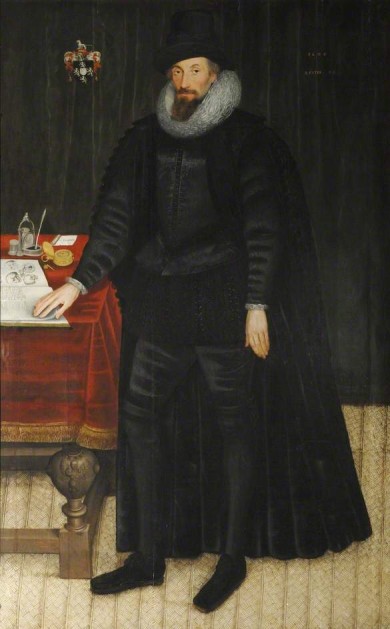Continuing the theme of health, medicine and Parliament, Dr Paul Hunneyball of the Lords 1604-29 Section considers how medical practices and language impacted on parliamentary proceedings under the early Stuarts…
History of Parliament biographies contain many incidental details about medicine in the early 17th century, though the picture that emerges is very different from the modern clinical experience. Although anatomical knowledge was improving, the human body was still generally believed to function according to the rules set out by the Greek philosopher Aristotle, which defined illness as an imbalance of four physical qualities, or ‘humours’. Accordingly, most treatments were designed to restore equilibrium, through blood-letting, purges, or the application of poultices (then known as ‘plasters’). While some tried-and-tested herbal remedies could be effective, many potions contained exotic ingredients which were either useless or actively harmful.
One Dr Antoine, who treated Adolphus Carey for smallpox in 1609 was subsequently prosecuted for hastening his end with ‘unknown medicines’. External factors were also considered relevant. Fashionable doctors such as Richard Napier were both physicians and astrologers. Diseases which defied diagnosis, such as the ‘languishing sickness’ endured by Emanuel Scrope, 1st earl of Sunderland, might well be blamed on witchcraft. The same factor was frequently invoked to explain mental illness; the estranged wife of John Villiers, Viscount Purbeck, was tried in 1625 on a charge of bewitching him with charms obtained from the notorious astrologer John Lambe. Alternatively, the epileptic Tobie Matthew was accused by his own father of ‘hypocritical dissimulations’ of illness. And of course, health and well-being were still widely regarded as evidence of divine favour. Francis Rous’s 1622 treatise, Diseases of the Time, Attended by their Remedies, was not a medical manual, but a fervent plea for national repentance to avert God’s wrath, which he discerned in a range of factors including plague epidemics. Indeed, when the 1625 Parliament was first postponed and then relocated to Oxford due to a plague outbreak in London, the House of Commons’ response was to call for a public fast in a bid to placate the Almighty.

Given the uncertainty surrounding medical treatment, and the presumption that health was influenced by divine providence, it’s not surprising that many lay people acquired a working knowledge of basic remedies. In a small way, this was reflected in Parliament. The early Stuart House of Commons included in its membership four actual doctors: John Bond, a former schoolmaster with a thriving West Country medical practice; Samuel Turner, a sometime physician to Anne of Denmark; John Gostlin, a future Regius professor of medicine at Cambridge; and Sir William Paddy, who was retained by three successive monarchs, and twice served as president of the Royal College of Physicians.
However, at least four other MPs are known to have taken a keen amateur interest in medicine, namely Nicholas Ferrar, William Whiteway II, Sir Gervase Clifton, and Sir Edward Conway jr. (later 2nd Viscount Conway). Another possible member of the latter group was Sir Robert Killigrew, who in 1613 supplied a purgative powder that may or may not have been used in the notorious poisoning of Sir Thomas Overbury by the countess of Somerset. The polymath Francis Bacon, Viscount St Alban, published on medical issues, his readership conceivably including William Paget, 5th Lord Paget, who collected books on medicine. At a more practical level, Dudley North, 3rd Lord North, reputedly discovered the healing springs of Tunbridge Wells, Kent after noting their similarity to the waters at Spa, in modern Belgium, which he had already sampled. (Mineral waters were a popular cure-all when other remedies had failed, with the famous Roman pools at Bath the pre-eminent English destination; a number of peers and MPs are known to have ‘taken the waters’ there, including Francis Norris, 2nd Lord Norreys, Robert Cecil, 1st earl of Salisbury, and, appropriately, William Bourchier, 3rd earl of Bath.)
Predictably, some of these men used medical imagery to enliven their political utterances. In 1606 Bond compared the impact on the crown’s finances of James I’s extravagance to a ‘body wasted with a continual burning fever’. During the same session, Paddy warned that ‘a just king must not take unjust courses; the head must not exhaust the vital spirits’. Six years later, Bacon tried persuading a reluctant James to re-summon Parliament, arguing that some medicines, which ‘in over-great quantity were little better than poisons, … [if] mixed and broken and in just quantity are full of virtue’.
However, by far the most significant of these interventions came in 1626, when Dr Turner spearheaded the Commons’ attack on the royal favourite, George Villiers, 1st duke of Buckingham. Asserting that ‘a good physician must consider the disease and the causes’, Turner diagnosed the nation’s ills as stemming from the duke’s malign political influence. Of all the resultant impeachment charges, the most controversial stated that Buckingham had interfered in James I’s medical treatment during the king’s final illness, potentially bringing about his death. Although the monarch already had a committee of doctors attending him, the duke encouraged him to try two additional treatments, a potion and a plaster. Such was the state of the profession that when the physicians were examined in Parliament, they were unable to say whether these concoctions had been harmful or beneficial, let alone what they contained. Nevertheless, Buckingham had gone behind the backs of the official medics, consulting a country physician with whom they were unfamiliar, and trying remedies which they hadn’t sanctioned. With the Commons intent on blackening the duke’s name in whatever way they could, these facts were sufficient to convince MPs that he had been up to no good. And although the impeachment charge failed to stick, the allegation that Buckingham poisoned James continues to circulate even today, despite the flimsy nature of the evidence.
PMH
Further reading:
- Alastair Bellany and Thomas Cogswell, The Murder of King James I (New Haven, 2015)
- Biographies of the peers listed above will appear in the History of Parliament’s volumes on the House of Lords 1604-1629 (forthcoming 2019).
